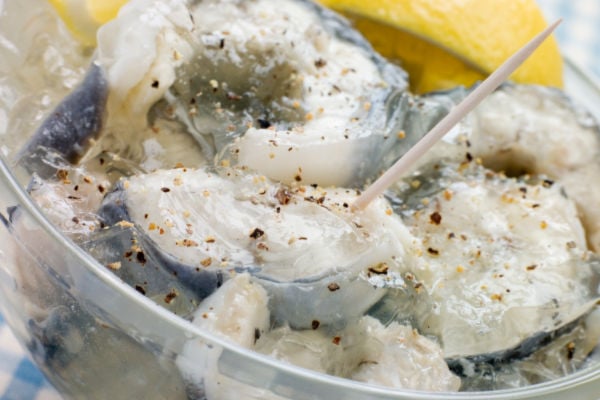The main difference between freshwater and saltwater eel is their taste and texture. Freshwater eel has a firmer texture with a rich, bold flavor that is mildly fishy, while saltwater eel is leaner and softer and has a blander, less pronounced flavor. While both varieties taste like salmon and have white flesh, the freshwater eel has much more oil than the saltwater eel.
While you can commonly see freshwater eel as an ingredient in sushi rolls, you can also use saltwater eel as a substitute. Read on to learn their similarities and differences, the flavors that complement them, and the dishes you can make with them. This article also offers an easy-to-follow eel preparation method.

Table of Contents
What Does Eel Taste Like?
There are two types of eel: freshwater (unagi) and saltwater (anago). They vary in flavor and texture. You'll often find the freshwater variety in sushi stores as the main ingredient in sushi rolls.
- Freshwater eel is a white fish that has a firm texture with a rich, bold flavor that is mildly fishy.
- Saltwater eel is leaner than the freshwater variety and has a blander, less pronounced flavor.

| Fresh water (unagi) | Salt water (anago) | |
|---|---|---|
| Flavor | Rich and bold | Bland, slightly sweet |
| Tastes like | Salmon | Salmon |
| Fishiness | Mild, not overwhelming | Mild, not overwhelming |
| Oiliness | High levels | Medium levels |
| Texture | Firm, yet delicate | Soft, delicate |
| Color | White | White |
Eel isn't a fishy tasting fish. Its texture is more enjoyable than snake meat, which tends to be a challenge thanks to many small bones. But, if you have fussy eaters or children, there are better options such as red snapper.

Related Posts:
What does walleye taste like? Is it worth the price tag?
A full comparison of sardines and anchovies. Do you know the difference?
What does salmon taste like? Find out more here.
What does fugu taste like? The high-priced Japanese delicacy.
What can I use instead of eel sauce?
What flavors complement eel?
Traditional Japanese ingredients such as soy sauce, fish sauce, and mirin work well with eel. A little sugar or similar sweet ingredients help to balance the saltiness.
| Seasoning | Sides |
|---|---|
| garlic | steamed vegetables |
| paprika | omelet |
| bay leaf | rice |
| turmeric | noodles |
| rosemary | quinoa |
| fennel | green onions, nori & wasabi |
Dishes from around the world
England
The English prefer eel served cold as a terrine. It is jellied and sold in tins at supermarkets. To make this recipe, the meat gets chopped into pieces then boiled in stock. Once cooked, the eel sets like jelly.

This product tastes like salmon, but it has a richer, more fatty mouthfeel and has the texture of Spam meat.
Japan
If there's one nation that relishes eel more than any other, it's Japan. The most popular use of this meat has to be sushi, but there are a few other classic dishes.
Kabayaki is hugely popular and is a similar style to teriyaki. Butterflied eel gets grilled and then brushed with a sauce. Often it is made up of ingredients like soy sauce, mirin, sake, and sugar.

Unadon takes the kabayaki method one step further. The kabayaki eel is served in a large donburi bowl on a bed of rice.
Europe
Angula is revered in Spain and some other parts of Europe. This dish uses elvers that are sautéed with garlic, chili, and olive oil. These baby eels are two inches long and translucent. Due to their age, you'll notice a different texture too. Elver tastes like whitebait.
Harvesting elver is controversial as it doesn't allow them to mature and reproduce. In many parts of the world, catching elver is illegal, and hefty fines are imposed.
Worldwide
Smoked eel is sough-after in many parts of the world, especially Europe.
Recommended Preparation Method
Eel skin is tough, slippery, and not easy to remove when you begin cleaning it. The secret is to remove the skin as soon as the fish is caught. If you buy from the market, be sure to select a specimen that's still alive in a tank. Once it dies, the fish begins to dry out, making the skin an even bigger challenge to remove.

- Use a sharp knife to slit the skin and circle around the body. The best place to start this slit is towards the head of the eel, behind the gills.
- Now begin to pull the skin off. It won't come off without a fight. You may consider using pliers for a better grip as you'll find the surface slippery. Use your knife to loosen extra stubborn portions of the skin.
- Once removed, begin to gut the eel. Cut lengthways along the bottom of thee fish then reach inside and remove the guts.
- The cut eel will flatten out (butterfly) quickly. Use a knife to scrape off any leftover entrails then rinse.
Frequently Asked Questions
Eel is an easy protein to cook thanks to its high fat content. You can grill, sauté, steam, smoke, or bake this fish.
Eel is known as elver in its infancy. In Japan, freshwater eel is called unagi, and the saltwater variety is called anago.
Store raw eel, in an airtight container, in the fridge for one day. Freeze the fish in plastic wrap or foil for up to six months. If you have cooked meat, store it in an airtight container for one day in the fridge.
Avoid eating raw eel as its blood is toxic and can cause death in humans. The blood is a defense mechanism to deter predators from eating them.
Snake tends to be bland, sinewy and riddled with small bones while eel has a richer, bolder fishy flavor.
Electric eels are not recommended for consumption as they have very little flesh. Most of their body is made up of organs that are designed to create electric shocks.

Summing Up
If you've ever wondered what eel tastes like, you wouldn't be alone. It's one of those foods that don't appeal to many due to their slimy, snake-like appearance.
You'll get a different flavor from an eel depending on whether it's from the ocean or freshwater. I prefer the saltwater variety because the taste is milder and the texture noticeably softer.

If you're worried about the flavor of eel, you shouldn't be. It isn't a strong, overbearing fishy taste. It also doesn't have any overwhelming, unfamiliar flavor that'll shock you. However, I wouldn't recommend eel if you're feeding fussy eaters or kids. There are so many other types of seafood that are more kid-friendly such as red snapper or shrimp.
As with any seafood, preparation and cooking will impact the final dish. A skilled chef can transform this unpleasant-looking fish into a delicious meal. Have you tried eel before? What did you think of the taste and texture? Let us know in the comments below.
Further reading:
What does octopus taste like?

Leave a Reply